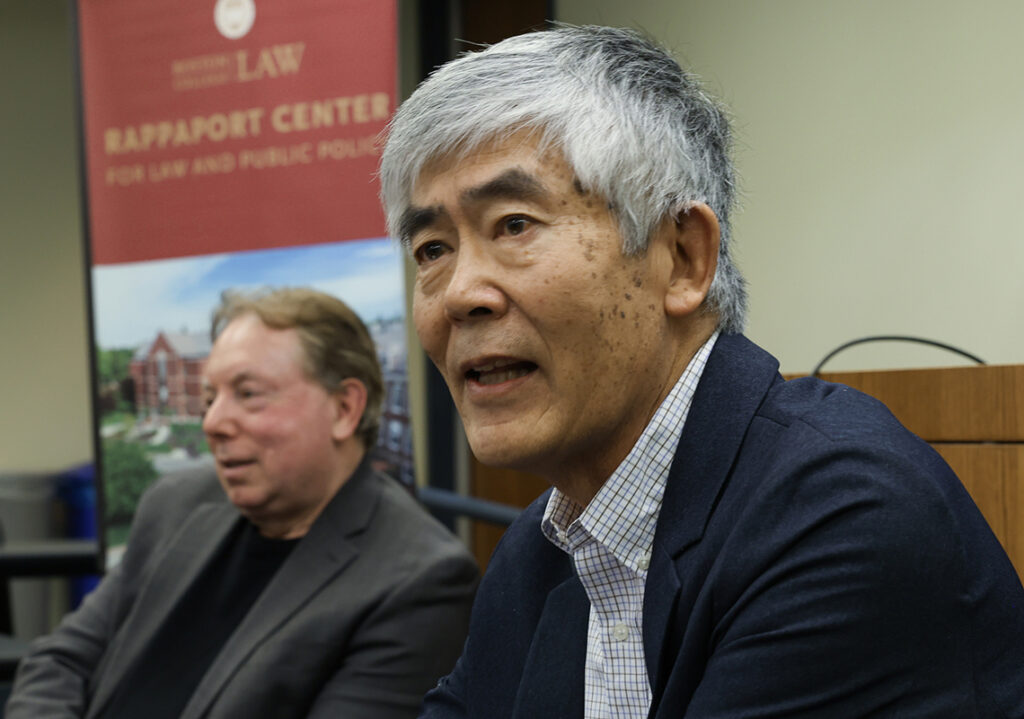The Rappaport Center for Law and Public Policy hosted a conversation in March on the state of immigration in a contentious age. The participants were Hiroshi Motomura, the Susan Westerberg Prager Professor of Law at UCLA, and BC Law Professor Daniel Kanstroom.
Kanstroom, who is faculty director of the Rappaport Center, began with an outline of the current immigration climate. “We live in very interesting and challenging times,” he said, highlighting two important points. “The issues are technical, but we’re talking about real people with real lives.” The second is that although the framework for the conversation is US law, the issues are inevitably global.
To illustrate this point, Kanstroom showed a global detention map, recognizing that tens of thousands of migrants sit in detention centers, both government and private, awaiting adjudication or deportation. The global reality speaks to a deeper, more theoretical reality behind immigration issues. “It’s inherently in our human nature to move,” Kanstroom explained. Unfortunately, this tendency often collides chaotically with another fundamental aspect of humanity. “We are also, inherently and inevitably, rational, social creatures with powerful urges toward community, work, and prosperity,” Kanstroom said.
This led Kanstroom to two questions: Can these aspects of human nature and society be reconciled? What is the law’s role in this reconciliation? “Immigration law is famously anachronistic and highly discretionary,” Kanstroom said. “Who says what the law is? In this particular realm, it’s particularly complicated.”
With this background, the talk shifted to a conversation between Kanstroom and Motomura, discussing the concept of sanctuary, its historical rhetoric, and the current role it plays in the immigration narrative. Although immigration law is primarily federal, certain areas like marriage, health, and education are governed by states, intertwining federal and state laws. State and local sanctuary policies may restrict state and local police to arrest for federal civil immigration violations, or to detain individuals on civil immigration warrants.
These sanctuary policies focus on prohibiting, forbidding, and restricting certain actions, but Kanstroom was careful to point out that none of them is designed to shield criminals from immigration enforcement. “The definition of sanctuary is quite elusive,” Kanstroom said, and turned to Motomura for his perspective.
Motomura tends not to use the word, “sanctuary,” given its myriad of meanings. “It’s only one of the few words used by both sides, one as an epithet or accusation, and one as a badge of honor,” he explained. Today, it’s often viewed through a lens of evoking enforcement, in a rhetoric of mass deportation. People view sanctuary as something that undermines the laws and the measures in place to protect them, Motomura observed, although sanctuary is more than what you see in the enforcement dimension. “It’s a way of defining community that goes beyond enforcement,” he said.
When asked why there is so much energy being directed towards immigration and sanctuary, Motomura pointed toward three obstacles standing in the way of mass deportation: “operational, legal, and political.” States and cities are important decisional locations, and they reflect a vision of what this nation should be. Their political resistance is an obstacle to mass deportation. “Fewer were deported under Trump [the first time] than under Obama,” Motmora noted, explaining that this was in part because of the lack of cooperation of states and localities.
The very idea of a welcoming, or sanctuary, city is subversive, said Motomura. In that sense, the narrative of Boston as a sanctuary that is safe and friendly for immigrants that Mayor Michelle Wu—a member of the Rappaport Center’s Advisory Board—put forward in her testimony before Congress on March 5, was a counternarrative to the Administration’s vision of immigration law as a wall that keeps invaders out.
At an operational level, the obstacles come down to how society and police engage with immigration at the local level. The subversion of welcoming communities often leads to self-deportation. “If you make people feel uncomfortable, then they may leave on their own,” Motomura said. Legally, new policies are being made toward non-citizens that increase the scope of federal power.
The speakers concluded by comparing the tension in immigration law with the historical resistance to fugitive slave laws. “It’s interesting how we think about that period now,” Motomora said. “How will we think about this period 50 to 100 years from now? How do we think about history and morality when we’re in the historical moment?”
Photograph by Reba Saldanha


